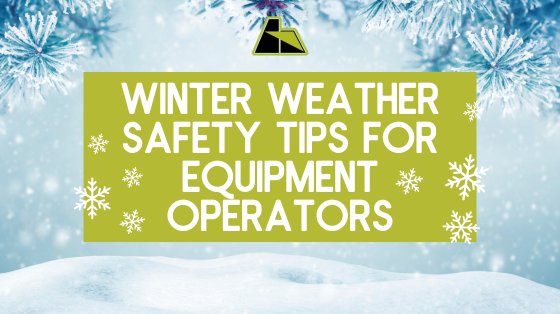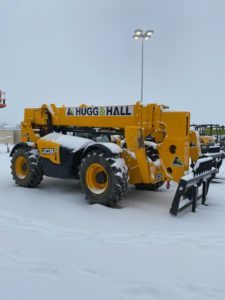
Winter Weather Safety Tips for Equipment Operators
When temperatures drop, your equipment and operators are more at risk. Winter construction safety is a vital part of any jobsite!
Equipment has trouble operating when it’s below freezing. You’ll likely experience battery issues around 32ºF, though it might not completely halt your work.
For equipment that’s diesel-powered, there’s additional concerns with winter construction safety.
Spencer Hale, Utility Services Sales Manager, has seen equipment start to struggle for several reasons when the temperatures drop.
We start to see issues when the diesel starts to freeze. It’s right at the freezing mark, 32ºF, that the paraffin in diesel fuel begins to stiffen.
Although this change won’t prevent you from using the equipment, it serves as a warning to start using an anti-gel.
These solutions can help keep your equipment from breaking down or getting permanently damaged.
Before operation:
Address fuel and engine needs.
Don’t fill the DEF tank all the way in winter. According to Spencer Hale,
The freezing point of DEF is 12ºF. If you’re using the equipment in low temperatures, it’s important to leave some room in the DEF tank.
If it is completely full, when it freezes, the water in it will expand and could crack the tank.
The amount of fuel conditioner you will need varies depending on the brand and model of the machine, so check the manufacturer’s recommendation. Always match the fuel conditioner to the type of fuel you’re using (e.g. low sulfur).
Use coolant that complies with ASTM standard D-621, with a freeze point low enough for your climate. If coolant freezes, it can crack the engine block and ruin the engine.
Check for water in chain tanks, final drives, swing gear baths, and gear boxes.
Prepare and protect batteries.
Clean and fully charge batteries, then disconnect the power leads.
Never store discharged batteries. Colder temperatures slow the discharge rate of fully charged batteries.
Start machines at least once a month and bring them to operating temperatures, but avoid starting them in extremely cold weather.
Store equipment if needed.
If all else fails and your machine won’t start, make sure you get it inside if possible.
During operation:
Let machines warm up.
Give equipment some time before operating. Spencer Hale told us,
Direct some heat on the tank and when unthawed and the machine starts, close the service doors on the unit and the internal compartment temperature should keep it from freezing.
You will need to heat up the unit every morning prior to use if the unit has sat overnight.
Go slow, and expect poor traction.
Icy patches can form quickly, and cold can change tire pressure and cause under-inflated tires. Wheels and tracks are both susceptible to slipping on ice or frozen ground.
Be aware of where you’re traveling.
Ramps and bridges are prone to ice formation and may freeze.
Make sure your route is clear.
Snow and ice can hide ditches, materials, and water. You can set up traffic lanes to minimize the risk.
Keep windows clear.
Ice and condensation build up quickly and make it hard to see. Make sure your operators know to stop immediately if they are struggling with visibility.
Provide extra lighting.
You can help keep your team safe by ensuring they can see well on dark days or after sunset.
When operating equipment:
Watch for frozen metal. When metal freezes, it can draw heat out of your skin and cause a cold burn. It can also cause skin to freeze to metal, A Christmas Story-style.
You’ll also want to check for ice on steps and grip plates. Be careful when climbing in and out of machines, use the three points of contact, and look for ice before you touch the machine.
General cold-weather concerns:
It’s obvious that a big part of winter construction safety is staying warm, but do you know the specific issues to watch out for?
Hypothermia
Early signs of hypothermia include shivering, loss of coordination, confusion, and fatigue.
Prolonged hypothermia leads to blue skin, dilation of the pupils, lowered pulse rate, and a possible loss of consciousness.
If an individual on your team is experiencing the symptoms of hypothermia, alert the job supervisor and request medical assistance.
Move the victim into a warm area. Remove any wet clothing and cover the victim with additional clothing or blankets. Warm beverages may help increase their body temperature.
Once their body temperature has increased, keep them warm and dry.
Frostbite
Frostbite begins with a loss of feeling and color in affected areas, and can cause permanent damage to body tissue. It can even lead to limb amputation.
Frostbite symptoms include reduced blood flow, numbness, tingling, stinging, and pale, waxy skin. The nose, ears, cheeks, chin, fingers, and toes are most commonly affected by frostbite.
If an employee is suffering from frostbite, take them to a warm area. The victim should avoid using the affected appendage and immerse it in warm—never hot—water.
If no warm water is available, keep the affected area warm with body heat. Never rub the frostbitten area and do not expose it to direct heat.
Trench foot
Trench foot is an injury caused by exposure to wet and cold conditions for longer than 10 hours. If the temperature is below 60°F and the worker’s feet are constantly wet, trench foot is a legitimate concern.
Symptoms include discoloration, numbness, lower-body cramps, swelling, blisters, and subdermal bleeding.
To care for trench foot, remove the victim’s shoes and socks and dry their feet. Request medical attention.
The victim should not try to walk, because walking can cause additional damage.
Dehydration
Even in winter, dehydration is a concern. This is especially true because workers are less likely to think they need water.
Encourage employees to take regular breaks to warm up and drink water or warm fluids.
Reduce worker fatigue and keep energy levels up.
Limit activities that create swelling or reduce circulation, and provide heated break spaces.
Schedule shifts during the warmest part of the day.
Allow frequent breaks in a warm area, and provide hot drinks.
Update employees’ PPE for colder weather.
Make sure all employees have proper PPE and know to dress in layers, but that there is no loose fabric on their PPE that could get caught in a machine.
Synthetic fabrics that wick away moisture are great, because sweating can cause hypothermia as it dries.
Employees should have waterproof, nonslip, insulated boots. Gloves should be warm, but flexible enough to allow employees to use tools.
Make sure eye protection has an anti-fog coating.
This article from Construct Connect has additional information about winter PPE.
Label areas that are hazardous in icy or cold conditions.
Apply tread tape to areas that may freeze or be slippery, such as stairs, doorways, ramps, and handrails.
Winter construction site safety requires extra attention and focus, but staying safe is vital.
Now that you know the dangers of winter conditions & how to prepare for them, you will be better able to stay active and productive while keeping your employees safe in winter weather.
For further preparation, we setting up a system of breaks to keep your employees safe.
Want more winter weather tips and tricks? Check out our resources section!
Back to News
Subscribe and unlock cutting-edge equipment insights, trends and tips!
Subscribe




